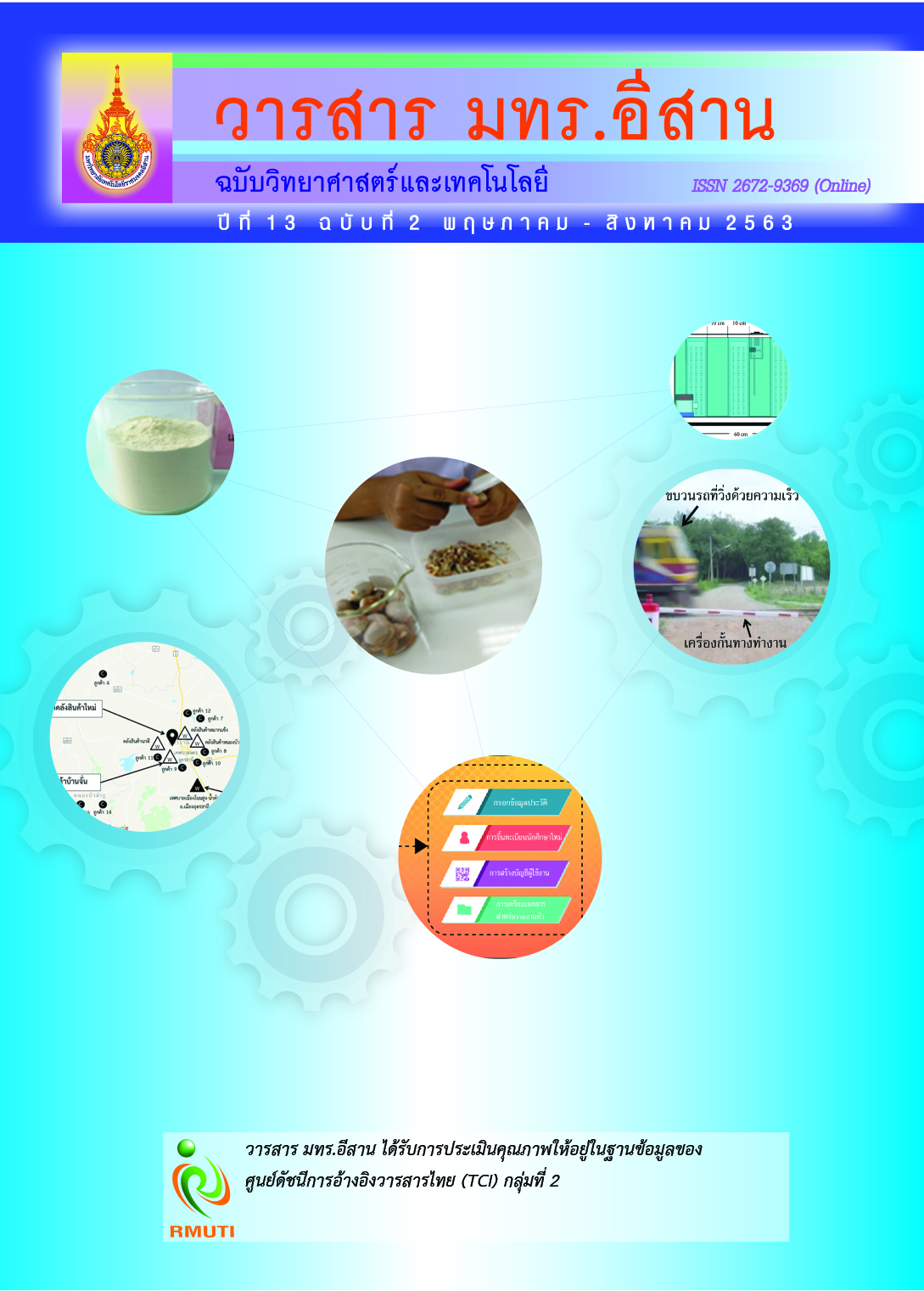Application Application of Jackfruit Seed Flour for Substitution of Color - Resist Substance in Batik Painting
Main Article Content
Abstract
The objective of this research was studied the production process of flour from jackfruit seeds, the chemical composition and viscosity of the flour, and the optimum formula of this color-resist substance. The chemical composition and viscosity of the flour were studied by means of Completely Randomized Design (CRD). The factors included in the study were the baking temperature for the jackfruit seed flour at 3 levels (60, 80, and 100 degrees Celsius), and the mixture of jackfruit seed flour and sticky rice flour in proportion of 30-gram weight at 5 formulas (28:2, 26:4, 24:6, 22: 8 and 20:10 grams), and 32 water, 2 oil, 23 saline and 13 limewater grams in equal weight in all formulas, for making the color-resist substance. The color-resist substance obtained was then painted on cotton fabric, followed by reactive color and sealed with sodium silicate. The thoroughly washed and dried fabric was tested for the Whiteness Index and color values fabric stiffness, the variance (Analysis of Variance, ANOVA), and the differences in the mean by Duncan’s New Multiple Range Test. It was found that the appropriate production process of jackfruit seed flour was in the following 6 steps: the seeds were thoroughly washed; the white cream and brown shells were peeled off; the seeds were cut into 1-2 millimeter pieces, left in hot air oven under the temperature of 80 degrees Celsius, then ground fine and sifted with a sieve of 80 mesh. The flour obtained was fine flour in white cream color with natural fragrance. From the chemical composition and viscosity test, it was found that the baked flour at 80 degrees Celsius had moisture, viscosity; and this was suitable as substitution of color-resist substance. Cont....
Article Details
References
Wongsa, J., Bhuwakietkumjohn, N., Kanlaya, T., and Chalalai, A. (2012). Design and Construction of Peeling and Size Reducing Machine for Jackfruit Seed. Agricultural Science Journal. Vol. 43, Suppl. 3, pp. 171-174
Boonkong, J. (2011). Study on Physicochemical Properties of Phosphate Starch from Jackfruit Seed (Artocarpus heterophyllus Lamk.). Journal of Food Technology, Siam University. Vol. 7, No. 1, pp. 40-50
Nutalai, P., Kaewsrithong, J., and Siriangkanakun, S. (2014). Effect of Wheat Flour Substitution with Jackfruit Seed Flour on Qualities of Cookies. In Proceedings of 1st National Conference on Science Education to Inspire Innovation. Mahidol University. pp. 225-227
Thumthanruk, B., Silapruang, S., and Aeimsard, R. (2012). Glucose Syrup Produced from Jackfruit Seed Flour and Tapioca Starch. Agricultural Science Journal. Vol. 43, Suppl. 2, pp. 149-152
Uttaphab, D. (n.d.). Carbohydrate Technology. Access (9 August 2019). Available (https://eu.lib.kmutt.ac.th/elearning/Courseware/BCT611/Chap3/chapter3_3.html)
Changpaiboon, S., Suraswadi, P., and Rungruangkitkrai, T. (2008). Development of Color Resistant Material from Thai Rice Flour for Resist Dyeing Process. In Proceedings of 43rd Kasetsart Univesity Annual Conference: Animal, Agro-Industry. pp. 444-451. Bangkok
Thairathonline. (2014). Agriculture Value of Waste Materials Agriculture to Textile Exports. Access (25 January 2019). Available (http://www.thairath.co.th/content/459958)
Klaijoy, C. and Mongkholrattanasit, R. (2012). Development of Color Resistant Material from Flour of Gaint Taro for Resist Printing and Dyeing. Faculty of Industrial Textiles and Fashion Design, Rajamangala University of Technology Phra Nakhon
Thongprayoon, S. (2007). The Improvement of Batik Design in Songkhla Province: the Study of Source of Production at Wangkaew-Wangkhaw Village, Tombon Bo-yang, Moung District, Songkhla Province. Faculty of Fine Art, Songkhla Rajabhat University
Phinkun, K. (2002). Batik Painting Techniques. Bangkok: Khaofang Publishing
Snow, P. (2017). How to Keep the Dough for a Long Time. Access (9 January 2019). Available (http://www.trueplookpanya.com/knowledge/content/55472/-blo-footip-foo-)
Wisansakkul, S., Oupathumpanont, O., Sungsanit, K., and Chulacupt, S. (2016). Development Production of Bioplastics from Jackfruit Seeds Starch. Burapha Science Journal. Vol. 21, No. 2, pp. 216-228
Narklor, D., Sungnark, A., and Limroongreungrat, K. (2011). Improvement in Quality of Jackfruit Seed Flour by Pregelatinization. Burapha Science Journal. Vol. 16, No. 1, pp. 12-21
Klaijoy, C. (2011). Making Batik on Silk Using Tapioca Starch to Resist Printing and Dyeing. Colourway. Vol. 17. No. 97. pp. 35-38
Sriraod, K. and Piyajomkwan, K. (2003). The Technology of Flour. Edition 4, Bangkok: Kasetsart University
Kachachat, P. and Jieyin, L. (2015). Resist Printing of Cotton and Silk Fabric with Carboxymethylcelluiose from Wild Taro Using Reactive Dyes and Batik Technique. Technology Program in Textile Chemical Technology, Faculty of Industrial Textiles and Fashion Design, Rajamangala University of Technology Phra Nakhon
Masae, M., Sikong, L., and Kooptarnond, K. (2013). Comparative of Paraffin and Turpentine Used in Wax Resist Dying on Batik Fabric. Journal of Community Development Research (Humanities and Social Sciences). Vol. 6, No. 1, pp. 31-41
Anunvrapong, A., Noodang, P., Pariman, B., Jiraboon, S., and Wongsathongdee, S. (2017). The Product Development of Batik using Natural Dyes Mixing Technique. Wrea-wa Kalasin Journal of Kalasin Univerity. Vol. 4, No. 2, pp. 207-222
Khunchaikan, J., Chonsakorn, S., and Mongkholrattanasit, R. (2018). Physical Properties of Yok Denim Nakhon Fabric. RMUTI Journal Science and Technology. Vol. 11, No. 3, pp. 130-143


